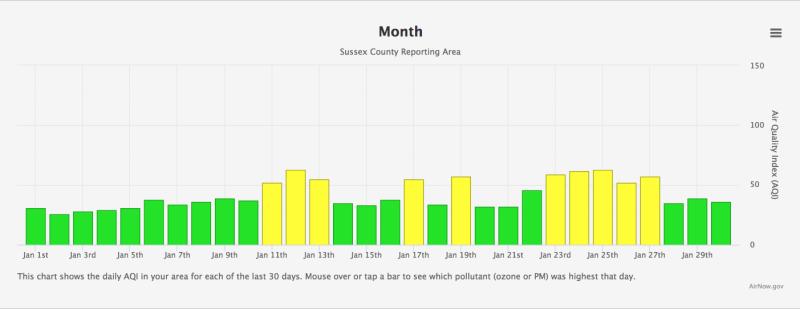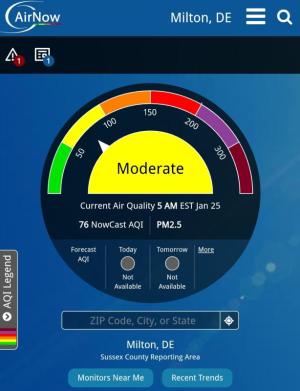Sussex saw moderate spike in air pollutants during cold spell
A couple weekends ago, I woke up to an air-quality alert on my phone. Curious, I went to the airnow.gov website, which is run by the Environmental Protection Agency and provides air-quality reports for any area of the country. It’s an information source I’ve periodically monitored ever since the Canadian wildfires in 2023 covered much of the East Coast in smoke.
The website said the air quality for the area that day, Jan. 25, was in the low end of the moderate range, which is generally considered acceptable. However, there was a separate notice on the website issued Jan. 9 about the wildfires in California affecting air quality in portions of the state. It wasn’t exactly clear to me if “state” meant California or Delaware.
In addition to current alerts, the website also has historical data on air quality dating back 30 days. According to that data, since the Jan. 9 notice was issued, there were 10 days in Sussex County that were in the moderate range, from Jan. 11 to Jan. 27.
I hadn’t heard about smoke from California traveling across the country, and the skies weren’t noticeably cloudy like they were in 2023, but I was now more curious, so I reached out to the EPA. The short of it is that it wasn’t California smoke.
David Sternberg, a public affairs officer for the EPA, said the Jan. 9 notice is a system-wide alert for the California area specifically. It is unlikely the moderate air quality experienced in Milton on the dates identified were related to the California wildfires, he said.
So far, said Sternberg, the weather patterns and atmospheric conditions around Los Angeles have not been conducive to transporting smoke or pollutants eastward and over such a long distance. While wildfires from western states can have significant impact locally and regionally, their effects generally do not extend as far as the East Coast, he said.
Speaking to the local air quality, Sternberg said an air-quality index of moderate during the winter months in the Delaware area is not uncommon. It is typically associated with wintertime meteorological conditions, such as inversions where warmer air aloft traps colder air, and pollutants, at the surface. Inversions and other factors like reduced sunlight and lower wind speeds can contribute to a buildup of pollutants, he said.
If not West Coast smoke, then what?
Sternberg’s explanation makes sense, and I feel like I would have heard about the smoke making its way across the country.
But if the smoke from California isn’t causing the multi-week spike, then what could have been? I had my own working theory that there was an unusual amount of salt in the air in the weeks following the snow we got the first week of January. My thinking was that there was a lot of salt dumped before, during and after the snowstorm, and then no precipitation to wash it away. Also, since the temperatures plunged afterward, there was no melting of snow onto streets and roads to keep the salt out of the air.
Sternberg said the salt wasn’t the likely cause either. Road salt can contribute to particulate matter levels, but it primarily comprises larger particles that do not travel far from roadways and would only be detected by air monitors near heavily treated roads, he said.
Instead, said Sternberg, the more likely contributors include the combined factors of increased household wood burning, which releases fine particulate pollution, as well as meteorological conditions. Snow cover can introduce local inversions, and colder temperatures limit vertical mixing, trapping pollutants closer to the ground, he said.
Well, that makes sense too. If you look at the bar graph I provided, the dates of the spikes – Jan. 11-13, Jan. 17-19, Jan. 23-27 – were primarily weekends when people were home. I know we definitely had our fireplace going during the cold spell. I imagine we weren’t the only ones.
Joke of the Week
The Super Bowl is this weekend. Between the two teams playing – Eagles and Chiefs – I’m going to stick to rooting for the East Coast team, but I do appreciate the greatness of what the Chiefs have accomplished over the past decade. That’s why I’m not going to have a joke about either. Instead, here’s one about the Cowboys. As always, send jokes to cflood@capegazette.com.
Q: Why does the Cowboys’ playbook have a map?
A: To help them find the end zone.
Chris Flood has been working for the Cape Gazette since early 2014. He currently covers Rehoboth Beach and Henlopen Acres, but has also covered Dewey Beach and the state government. He covers environmental stories, business stories and random stories on subjects he finds interesting, and he also writes a column called Choppin’ Wood that runs every other week. He’s a graduate of the University of Maine and the Landing School of Boat Building & Design.


























































